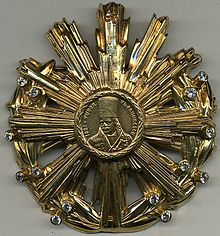Order of Tudor Vladimirescu
The Order Tudor Vladimirescu ( Romanian Ordinul Tudor Vladimirescu ) was founded on April 13, 1966 by Decree No. 272-CS of the President of the State Council for special merits in the establishment and defense of the social and state order. The foundation was published in Buletin Oficial No. 16.
The medal was awarded to people who, by participating in the revolutionary struggle, made a significant contribution to the achievement of democratic freedoms and the establishment of socialism. It was also awarded to nationals and foreigners who made a special contribution in international political life to promoting the principles of international cooperation, maintaining international security and peace, and developing friendship and cooperation with the Socialist Republic of Romania have done.
Order classes
The order consists of five classes:
- 1st class - gold with stones
- 2nd class - gold
- 3rd class - silver
- 4th grade - antique silver
- 5th grade - bronze
At an unknown point in time, a special tier was donated for foreign heads of state and dignitaries, for which the 1st class medal was worn as a breast star and the 2nd class symbol was worn in a reduced form as a shoulder ribbon decoration.
Order decoration
The order, designed by the Romanian sculptor Nestor Culluri, has the shape of a star with ten uneven bundles of rays. In the laurel-wreathed medallion is the bust of Tudor Vladimirescu with the inscription 1821 TUDOR VLADIMIRESCU . The background of the medallion varies depending on the class.
The 1st class medal is reddish gold-plated. A laurel wreath, open at the top, is woven into the lower seven rays of the star, on which there are seven a'jour set stones on the left and right. The background of the medallion is the color of the star. The medal of the 2nd class corresponds to that of the 1st class, but without a laurel wreath and without stones. The third class has the same shape as the second class, but the background of the medallion is enamelled green. In the fourth grade the medallion background is enamelled red and in the 5th grade orange.
For women, the medals existed in a reduced size.
Carrying method
The following bands existed for the interim clasp:
- 1st class: red with a gold 7 mm wide central stripe
- 2nd class: red with two gold median stripes 3 mm wide
- 3rd class: red with three gold median stripes 2 mm wide
- 4th grade: red with four golden central stripes 1.5 mm wide
- 5th grade: ror with five golden central stripes 1.5 mm wide
See also
literature
- Kurt-Gerhard Klietmann : Phaleristics. Volume 1: Romania. The Order Collection, Berlin 1975, ISBN 3-87778-400-3 .
- Rainer Schmitt: The awards of the People's Republic and the Socialist Republic of Romania 1948 to 1989. PHV, Konstanz 2001, ISBN 3-936529-78-7 .


